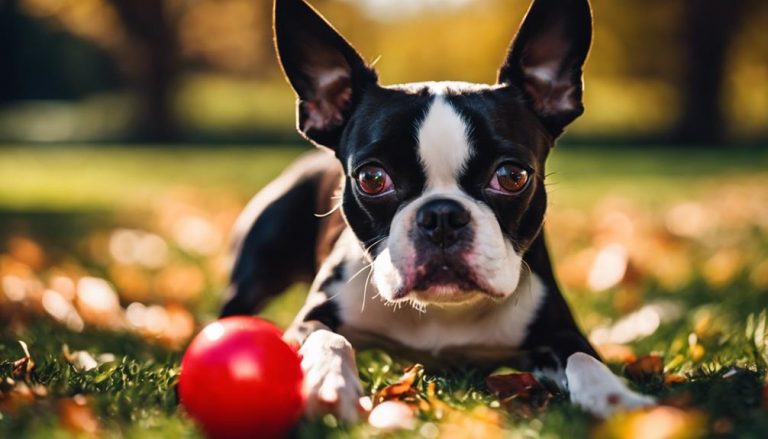Boston Terrier: Charismatic, Loving Companion
The Boston Terrier is a breed that began in the United States around the late 19th century and was named Massachusetts’ state dog in 1979. These dogs stand between 10 to 12 inches tall and weigh anywhere from 12 to 25 pounds. They often live between 11 to 15 years and are known for their friendly and gentle temperament.
This breed is easily recognized by its compact, muscular frame and distinctive tuxedo-like coat markings, which require consistent grooming. Their diet should be specific to their nutritional needs. Because of their short snouts, Boston Terriers are susceptible to breathing issues, so it’s crucial to keep up with their health care and vet visits.
Boston Terriers are great for apartment living due to their adaptable nature and loving personality. They make excellent companions, and getting to know how to care for them can greatly enhance the bond between you and your pet.
Key Takeaways
- Boston Terriers suit both family and apartment life.
- Need daily exercise; interactive games are great.
- Tuxedo coat, muscular but watch their health.
Quick Facts
The Boston Terrier, hailing from Boston, Massachusetts, has been Massachusetts’ official state dog since May 14, 1979. This breed is easily recognized by its short, smooth coat and is often referred to as the ‘American Gentleman’ due to its elegant, tuxedo-like markings. With a blend of style and friendliness, the Boston Terrier fits into the Non-Sporting breed group, highlighting its ability to adapt to various environments beyond traditional sports.
This breed’s compact and muscular build, along with its bright intelligence and sociable nature, make it an excellent companion. Boston Terriers generally live between 11 to 15 years, indicating their good health and vitality with proper care. Their coat is not just easy on the eyes but also easy to care for, requiring minimal grooming. This makes the Boston Terrier a great choice for those looking for a pet that doesn’t demand a lot of maintenance. The Boston Terrier’s rich history and unique characteristics have made it a cherished American symbol.
Overview
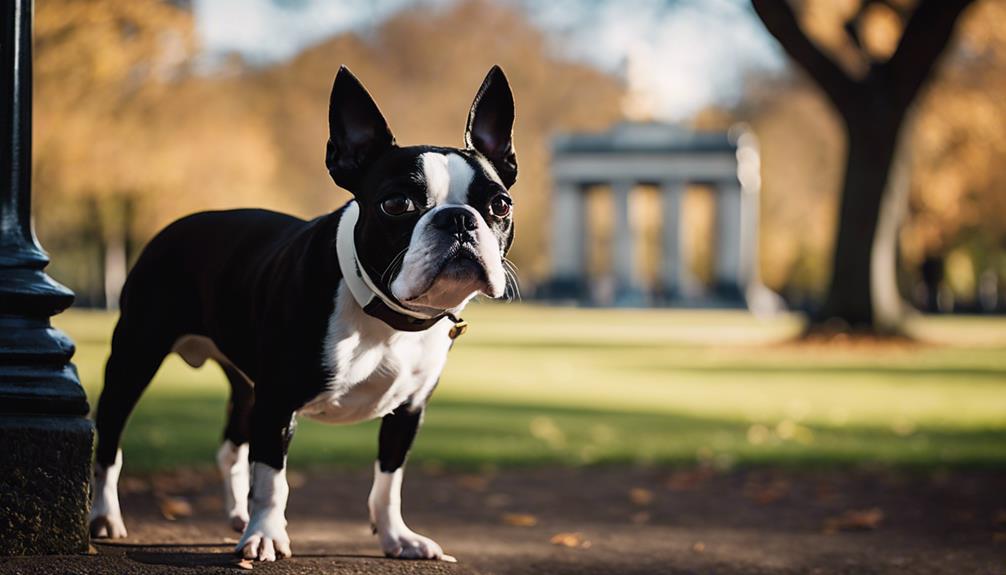
Dating back to the late 1800s in the United States, the Boston Terrier combines charm and elegance in a small package. These dogs are well-suited for both small apartments and larger homes, thanks to their modest size of 10-12 inches tall and a weight range of 12-25 pounds. They live about 11-13 years, showing that adopting one is a long-term commitment. The American Kennel Club recognized Boston Terriers in 1893, and they quickly became popular members of the Non-Sporting Group.
Boston Terriers are known for their friendly and gentle nature, earning them the nickname ‘The American Gentleman.’ This name not only highlights their classy look but also their easygoing and friendly personality. These traits make them great pets for various people and families. Their American roots emphasize their role as an iconic breed in the country, offering a mix of lively energy and faithful companionship that many dog enthusiasts cherish.
Tuxedo Coat Markings
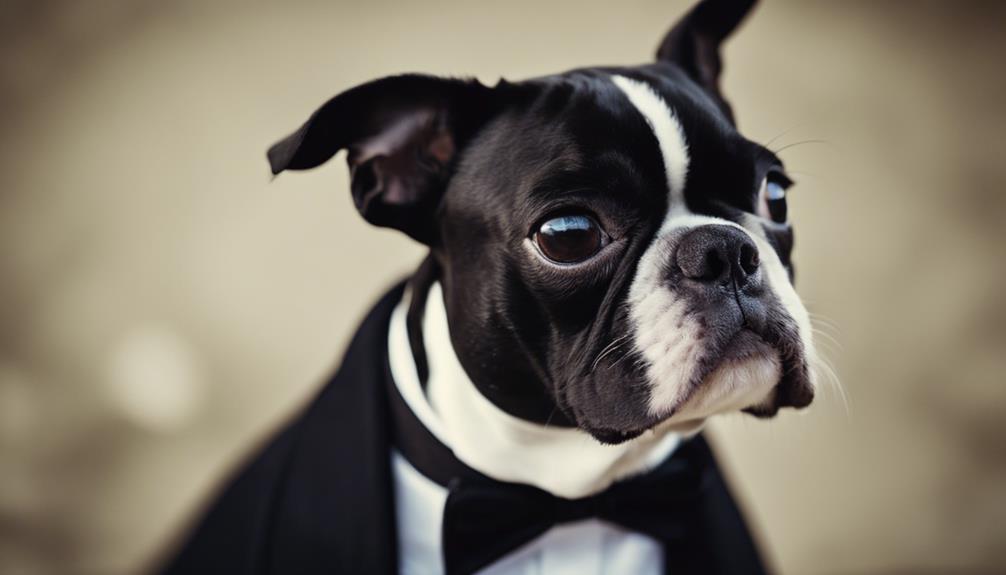
Boston Terriers are famous for their unique tuxedo coat markings, which perfectly capture the breed’s polished look. These markings mix white with either black, brindle, or seal, creating a distinguished pattern that’s key to their identity. Such a pattern isn’t just for show; it’s a critical requirement according to the breed’s standards, which clearly exclude any solid coat colors. The desired effect is one of symmetry, contributing to their refined appearance and leading to their nickname, ‘The American Gentleman.’
The specific arrangement of these coat markings, along with other breed-specific traits like the tail’s length and shape, are crucial in dog shows. Here’s what’s typically looked for in these dogs:
- Color Combination: Must be black, brindle, or seal with white to achieve the tuxedo look.
- Symmetry: This is preferred to enhance their elegant appearance.
- Tail: Should not be longer than 2 inches and can vary in shape.
- Breed Standard: Solid colors are a no-go; only tuxedo patterns are accepted.
- Nickname Justification: They’re called ‘The American Gentleman’ because of their distinct white markings.
These markings aren’t just for looks; they’re a significant part of the Boston Terrier’s heritage. The breeding standards carefully maintain this iconic appearance, showcasing the breed’s long history and the attention to detail breeders pay to uphold these characteristics.
Origin Story
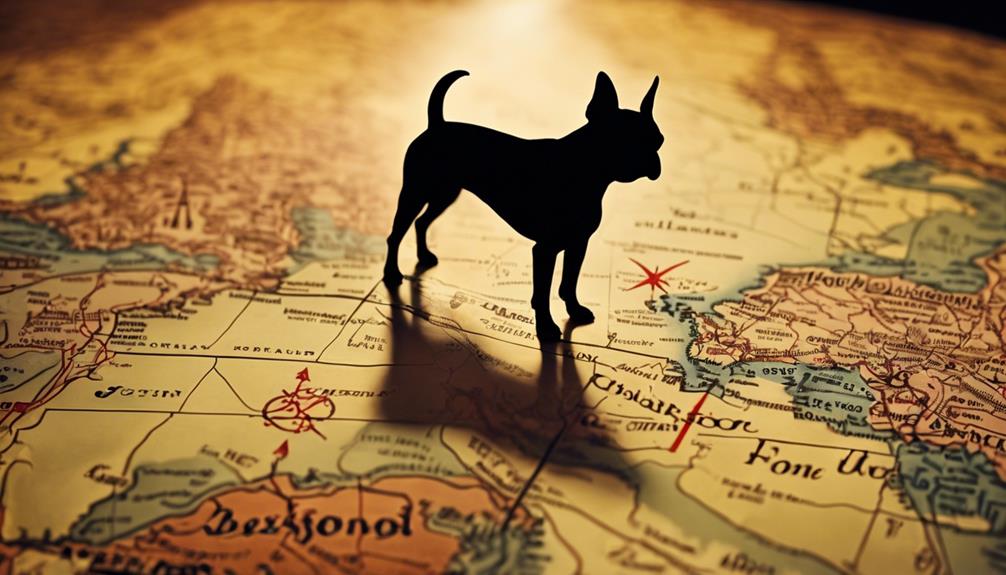
The Boston Terrier comes from a meticulous breeding effort, starting with a dog named Judge in the late 1800s. This effort was aimed at creating a breed with specific traits, leading to its official recognition by the American Kennel Club (AKC) in 1893. This marked a significant moment, cementing the Boston Terrier’s place in dog breeding history.
- A silhouette of Judge marks the beginning of the Boston Terrier’s family tree.
- An early gathering of Boston Terrier enthusiasts showcases the teamwork behind the breed’s development.
- The AKC’s certificate of recognition is a key achievement for the breed.
- An old photo of a Boston Terrier shows the distinctive look that breeders worked hard to achieve.
These elements highlight the Boston Terrier’s journey from a single dog to a beloved breed recognized for its unique characteristics. The AKC’s acknowledgment is not just a formality but a testament to the breed’s distinct identity and the thoughtful breeding practices that shaped it.
Early Breed Development
The Boston Terrier breed traces its roots back to the 1870s, starting with a dog named Judge. This moment marked the beginning of a breed that would become an American icon. Judge’s breeding with Gyp was a key step in creating the Boston Terrier we know today. These dogs were originally larger and bred for fighting but were gradually bred to be smaller and more compact.
In 1891, the Boston Terrier Club was established, and by 1893, the breed was recognized by the American Kennel Club (AKC). This recognition highlighted the breed’s rising status. The Boston Terrier is one of the few dog breeds that originated in the United States, showcasing the success of careful and intentional breeding to achieve a set of desired traits.
Notable Historical Figures
The Boston Terrier breed has its roots around 1870, thanks to the breeding efforts starting with a dog named Judge. This was a turning point in creating what we know today as the charming Boston Terrier. Breeders paid close attention to selecting offspring that showed the breed’s iconic tuxedo coat and friendly nature. This selective breeding was crucial in transforming the breed from its larger, more aggressive ancestors to the amiable, smaller dogs we adore today.
In 1893, the American Kennel Club acknowledged the Boston Terrier as a distinct breed. This recognition was not just a formality; it celebrated the Boston Terrier’s unique place as an all-American breed. The combined efforts of those early breeders are why the Boston Terrier enjoys such a revered spot among dog lovers.
Breed Recognition Journey
The journey of the Boston Terrier from its origins in aggression to its respected status today is a fascinating tale. It all started with a dog named Judge around 1870. His offspring were carefully bred to be smaller, transforming the breed from fighters to friendly companions.
In 1891, the creation of the Boston Terrier Club was a critical moment. It helped set the breed’s standards and establish its reputation in the dog community.
Just two years later, in 1893, the American Kennel Club recognized the Boston Terrier as an official breed. This recognition was a significant achievement. The Boston Terrier, with its distinctive tuxedo coat and friendly disposition, has become a beloved pet. They are now known as ‘The American Gentleman,’ a nod to their classy appearance and gentle manners. This transition showcases the breed’s incredible transformation over the years.
Compact Build
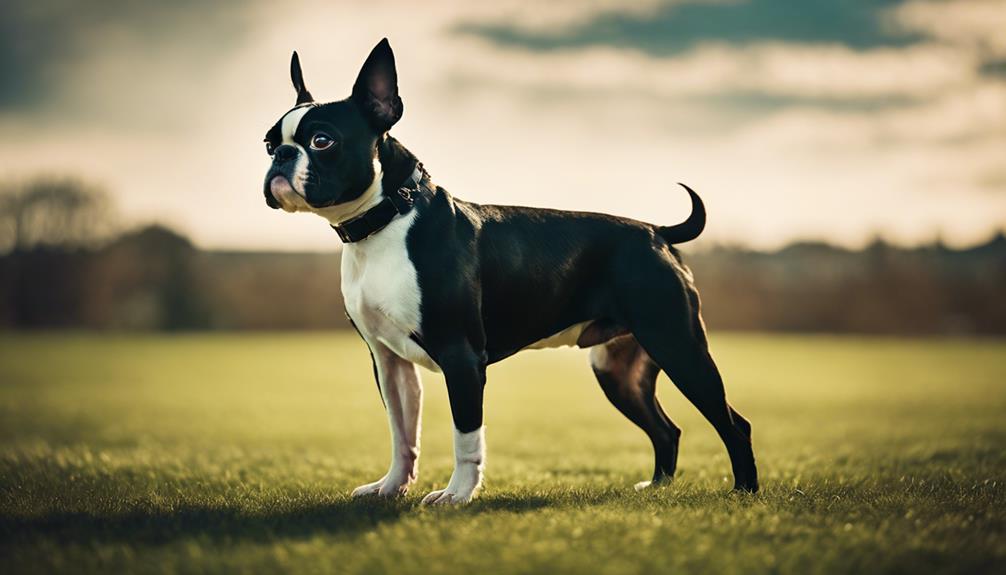
The Boston Terrier’s compact size plays a crucial role in its suitability for apartment living and the ease with which owners can manage them. This characteristic not only affects their look but also their lifestyle needs and how they fit into smaller spaces. Living in an apartment usually means less room, but these dogs thrive in such environments, making them a top choice for city dwellers.
- Perfect for Apartment Life
- Easy to Manage
- Health Considerations
- Activity Needs
Boston Terriers are great for apartment life due to their size. They don’t need a lot of room to move around, which makes them perfect for smaller living spaces. This quality also means they’re easier to handle, whether it’s grooming or taking them out for walks, which is a plus for owners, especially those who might find larger breeds challenging to manage.
However, their build also comes with specific health and activity considerations. Since they are a brachycephalic breed (meaning they have a short skull and nose), they can have respiratory issues. Owners need to be aware of this and ensure their pets don’t overexert themselves, especially in hot weather. On the exercise front, while they may not need as much space to roam, regular exercise is still vital to keep them healthy and happy. It doesn’t have to be extensive; daily walks and playtime will suffice.
Ideal Apartment Dogs
Boston Terriers are a top pick for those living in apartments. They have a small size that makes them perfect for limited spaces. Their need for exercise is moderate, satisfied by daily walks and some playtime, which keeps them happy and healthy in a smaller home.
The care for their coat is easy, needing just simple grooming, making them low-effort pets. Though they are generally healthy, it’s important to take them for regular vet visits to check for any issues specific to their breed. Being named the official state dog of Massachusetts in 1979 highlights their popularity and suitability for urban living, making them an excellent choice for those in apartments.
Ease of Handling
Boston Terriers are known for their compact size and light weight, making them easy to handle and transport. They typically don’t weigh more than 25 pounds. Their unique square head and upright ears make them instantly recognizable and contribute to their easygoing nature. Because they’re not heavy, they’re simple to pick up and move, which helps both the owner and the dog get around effortlessly.
Boston Terriers don’t need a lot of exercise, which is perfect for people who aren’t very active or have limited space. This makes them a great fit for apartment living or for those who love to travel. Their small stature, combined with their friendly and easy-to-manage personality, means they’re well-suited to a variety of living situations and lifestyles.
Health Implications
Boston Terriers are known for their short snouts and flat faces, making them cute but also prone to breathing issues. This condition, known as brachycephalic airway syndrome, can make it hard for them to breathe properly. Their unique facial structure also means they can overheat easily in warm weather or during too much play. It’s crucial for owners to keep an eye on their activity levels to prevent heatstroke.
These dogs often make snoring and snorting noises, which might sound adorable but are signs of their difficulty in breathing. On top of respiratory problems, their compact body shape can lead to spinal issues like intervertebral disc disease. Regular visits to the vet are essential to keep these potential problems in check. It helps ensure that any health issues related to their distinct build are managed well, keeping these friendly pets happy and healthy.
Exercise Requirements
Boston Terriers may be small, but they need about an hour of exercise every day to stay healthy and happy. Their size doesn’t stop them from being full of energy and eager to play. They do best with short, lively bursts of activity rather than long periods of physical exertion. This makes them perfect pets for city living or smaller homes where space is limited.
Interactive play sessions do more than just meet their physical needs; they also keep their minds active and engaged. This is crucial for their overall wellbeing. Keeping a Boston Terrier entertained and exercised can help prevent boredom and promote a healthy lifestyle, making them content and joyful companions.
Space Conservation Benefits
Understanding the exercise needs of Boston Terriers sheds light on the benefit of their compact size, especially for those living in cities or small spaces. Their stature, standing at about 10-12 inches tall and weighing between 12-25 pounds, makes them a great fit for apartments and smaller homes. These dogs don’t need a big backyard to stay active. A few daily walks and some playtime indoors are enough to keep them healthy and happy.
This makes the Boston Terrier an ideal pet for city dwellers or anyone looking to save space in their living environment. They bring the joy and companionship of a pet into the home without requiring a lot of room. This quality of the Boston Terrier makes it a smart choice for people who want a dog but have limited space.
Gentle and Affectionate Nature
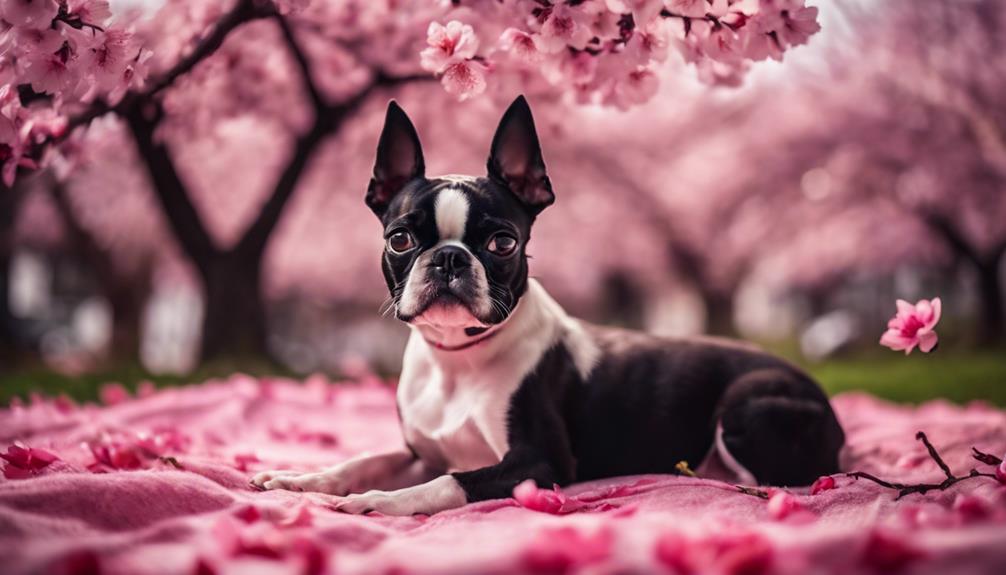
The Boston Terrier is a great choice for families, with a friendly demeanor that bonds well with both humans and other animals. This breed is especially good with kids and gets along with other pets when introduced early. They love spending calm moments indoors and are quick to show their love, making them a sought-after pet.
- Perfect for Families
- Gets Along with Kids
- Good with Other Animals
- Shows Love Easily
Boston Terriers are known for their loving nature, making them perfect pets for homes with children. Their friendly approach extends to other animals too, ensuring peaceful coexistence when properly introduced. Their calm and loving ways indoors highlight why they’re such a popular choice.
Ideal Family Pet
Boston Terriers are ideal for families due to their gentle and loving nature. They are particularly good with kids and other pets when they’ve been properly trained and socialized. To ensure they interact well with children, it’s important to teach them from a young age how to play gently. This helps prevent any snappy reactions if they’re treated roughly.
Boston Terriers can also live peacefully with other pets in the home. Their friendly behavior and ability to adapt make them perfect for a household with multiple pets, ensuring everyone gets along well.
Socializing With Children
Boston Terriers are known for their friendly and loving nature, making them great pets for families with children. It’s crucial for these dogs to learn how to interact with kids safely, and vice versa, to ensure everyone gets along. Training and supervision are key to creating a respectful and safe environment for both the dog and the child.
This way, Boston Terriers and kids can enjoy each other’s company without any issues, strengthening their bond. Teaching children how to gently play with their pets and setting clear rules helps prevent any accidents. With the right approach, Boston Terriers can become a cherished part of the family, offering companionship and love to everyone, especially the little ones.
Friendly With Other Pets
Boston Terriers are known for their gentle and loving nature, especially when it comes to interacting with other pets in the home. It’s crucial to introduce them to other animals properly and ensure they’re supervised during these interactions. This helps maintain a peaceful living environment for everyone.
Socializing Boston Terrier puppies is key to helping them get along with other pets. This process includes teaching them how to respect boundaries and interact politely with other animals. When done correctly, it helps them grow into well-adjusted adults who can easily fit into a home with various pets.
This approach doesn’t just benefit the Boston Terrier; it also makes life easier and more enjoyable for all pets in the household.
Expressing Affection Easily
Boston Terriers are affectionate and loving, making them perfect family pets. They show their love through cuddling, giving kisses, and wagging their tails energetically. These dogs crave human interaction, which helps them form strong connections with their families. Their friendly nature makes them great for those needing emotional support or therapy.
They are known for their patience and kindness towards children and other pets, enhancing their reputation as friendly companions. Boston Terriers are not just pets; they become an integral part of the family, bringing happiness and comfort to everyone around them.
Calm Indoor Companionship
Boston Terriers are known for their calm demeanor and loving nature, making them perfect for those who want a pet that isn’t too demanding. These dogs love spending time with their owners, showcasing their role as ideal indoor companions. They are incredibly affectionate and social, which makes them great for anyone looking for a friendly and loving dog.
Boston Terriers don’t need much exercise, which suits their preference for being around people. Their pleasant personality ensures a peaceful home environment, proving they are excellent companions who make their owners’ lives better simply by being there.
Brachycephalic Syndrome Risks
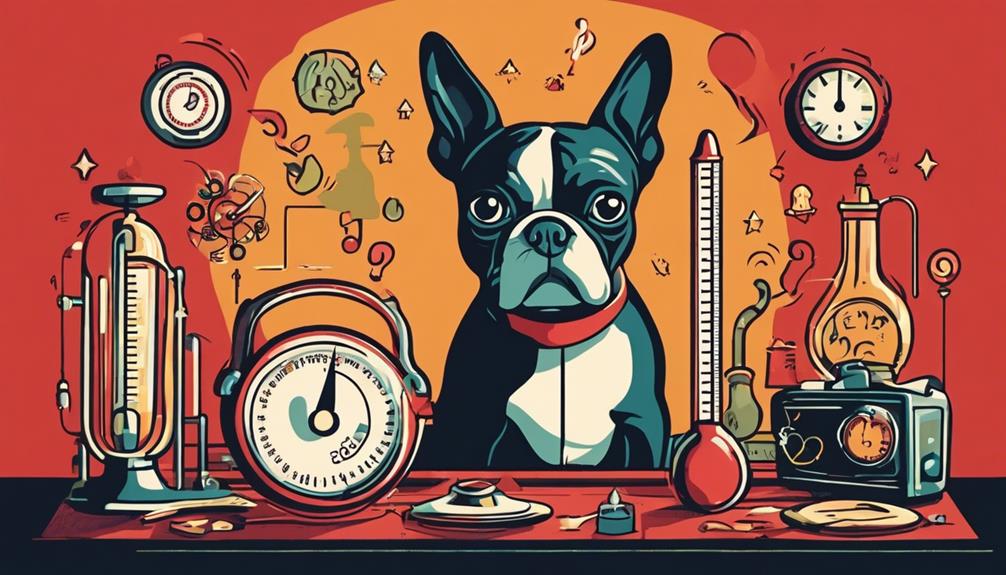
Boston Terriers, known for their short noses and flat faces, are more likely to face breathing issues due to their brachycephalic characteristics. It’s crucial for owners to understand the symptoms and manage the condition to ensure their pets live comfortable lives.
Signs your Boston Terrier may be struggling include difficulty breathing after just a little bit of exercise and making snoring sounds when they’re just dozing off. These dogs can also seem very uncomfortable and less willing to play or go outside when it’s warm or humid. To help prevent problems, using cooling vests or keeping your pet in a room with air conditioning can make a big difference.
Understanding these signs and knowing how to help your pet can prevent more serious issues from developing. Keeping your Boston Terrier cool and comfortable is key, especially during the hotter months.
Identifying Symptoms
Identifying the symptoms of Brachycephalic Syndrome in Boston Terriers is crucial for their health. Look out for signs like noisy breathing, snorting, and trouble catching their breath. These are key indicators of the syndrome common in dogs with short skulls. Be aware of overheating, not being able to exercise much, and sudden collapses, as these are also symptoms.
If your Boston Terrier pants a lot, gags, or throws up food, their airway might be blocked. A serious sign to watch for is cyanosis, where their gums turn blue due to not getting enough oxygen. Regular vet visits and careful attention to your dog’s health can prevent problems related to Brachycephalic Syndrome.
Breathing Complications
Recognizing the signs of Brachycephalic Airway Syndrome in Boston Terriers is crucial due to their unique head shape, which can lead to serious breathing issues.
These dogs have a compact skull structure, causing their air passages to be narrow and leading to respiratory problems such as loud snoring, snorting, and difficulty breathing.
In serious cases, surgery might be the only option to fix these breathing troubles.
It’s vital for Boston Terrier owners to keep an eye out for these health problems and get their dogs to a vet quickly if they notice any respiratory issues, to ensure their pets stay healthy and happy.
Prevention Strategies
Reducing the health risks for Boston Terriers with Brachycephalic Syndrome requires a well-rounded strategy focusing on a healthy lifestyle and changes in their environment. Keeping your dog at a healthy weight is crucial as it lessens the burden on their breathing, improving their overall health. It’s important to keep them cool, as hot weather can make breathing harder, so a comfortable, air-conditioned space is key.
Exercise is good for their respiratory health but should be adjusted to what each dog can handle to prevent pushing them too hard. A home with good airflow and a calm atmosphere helps in preventing stress that can affect their breathing. Keeping an eye out for any breathing troubles and getting quick veterinary care can prevent serious issues, ensuring your Boston Terrier stays healthy.
Grooming Needs
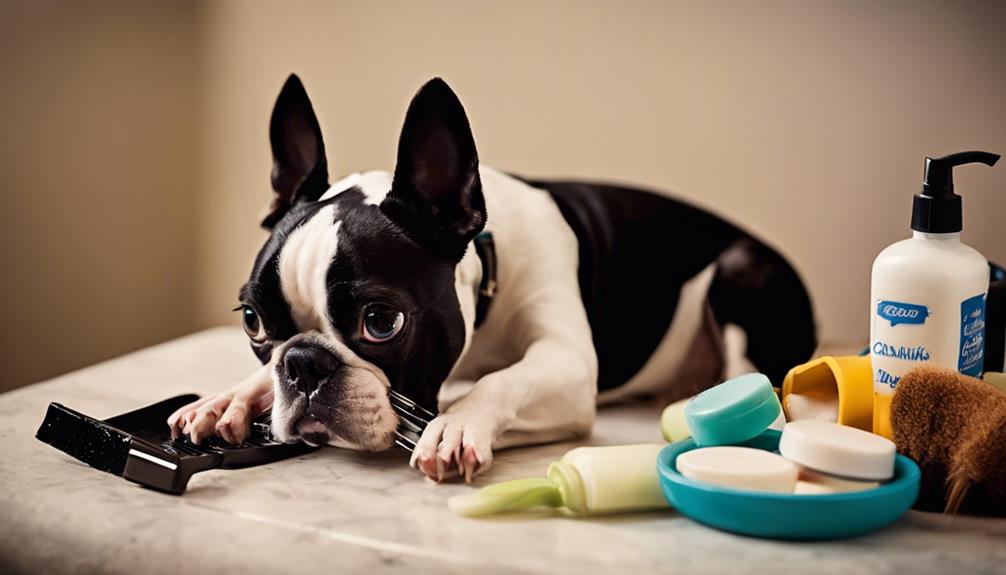
Boston Terriers are known for their short, smooth coats which makes their grooming routine pretty straightforward, yet it’s vital for their health. Keeping up with grooming helps keep their coat shiny and can help spot and prevent health issues early on. A good grooming routine includes brushing, bathing, and taking care of their ears and nails.
For their coat to stay shiny and to minimize shedding, brushing them every day is advisable. When it comes to bathing, it’s important not to overdo it to avoid drying out their skin; finding the right balance is key. Nail trimming is also crucial to avoid discomfort and ensure they can move around easily. Regular ear cleaning is necessary to prevent infections and keep their hearing in top condition.
Brushing daily helps maintain the coat’s shine and keeps shedding under control. It’s better to bathe your Boston Terrier just enough to keep their skin healthy without stripping it of natural oils. Cutting their nails properly can prevent pain and help with their posture and movement. Cleaning their ears is essential to stave off infections and ensure they can hear well.
These steps are not just about keeping them looking good but are essential for their overall health. With these simple practices, you can help your Boston Terrier stay happy, healthy, and looking their best.
Daily Brushing Tips
To keep a Boston Terrier’s coat shiny and healthy, it’s a good idea to brush it every day. A soft-bristled brush or grooming mitt works best for this breed’s short, smooth fur. This daily habit isn’t just about making your dog look good. It helps get rid of dirt and loose hair and stops the fur from getting tangled, especially in spots where knots can form easily, like behind the ears, under the legs, and around the tail.
Brushing your Boston Terrier regularly is key for a healthy coat and skin. It makes sure the skin’s oils are spread out well, giving the coat a nice shine. Also, it’s a chance to check your dog’s skin for any problems, bugs, or strange bumps. Catching these issues early can make treating them much easier.
Bathing Frequency Guide
Brushing your Boston Terrier every day is key to keeping their coat shiny and healthy. However, when it comes to bathing, doing it too often can cause more harm than good. For Boston Terriers, a bathing schedule of every 4-6 weeks is recommended. This frequency keeps their coat clean without stripping away essential oils that protect their skin.
Depending on how much your dog plays outside or their activity level, you might need to adjust how often you bathe them. To help keep their coat in top condition between baths, regular brushing is beneficial. It helps manage shedding and keeps their coat smooth.
Always choose a mild shampoo designed for Boston Terriers to avoid any skin problems and keep their coat looking its best.
Nail Trimming Techniques
Keeping your Boston Terrier’s nails trimmed is key to their comfort and paw health. Aim to trim their nails every 2-3 weeks. This stops nails from growing too long and causing your dog discomfort. When cutting their nails, use a sharp guillotine-style clipper made for small breeds. This tool helps you make clean cuts easily.
Be careful not to cut the quick, which is the part of the nail that has nerves and blood vessels. Cutting it can hurt your pet and cause bleeding. If you’re not sure how to trim your dog’s nails safely, it’s a good idea to ask a professional groomer or a vet for help. They can show you the right way to do it.
Regular nail care helps your Boston Terrier walk more comfortably and keeps them happy.
Ear Cleaning Essentials
Caring for your Boston Terrier includes keeping their ears clean to avoid infections and ensure they’re comfortable. It’s crucial to pick an ear cleaner recommended by vets, made with this breed in mind. Using a soft cotton ball or pad, gently clean the outer part of their ear to get rid of any dirt and wax. Never put anything deep into their ear canal to prevent harm.
Regular grooming should definitely include ear care for your Boston Terrier. This step is key to stopping ear infections before they start, which can cause a lot of pain and health issues for your dog. Making ear cleaning a part of your pet’s grooming routine is a simple way to keep them happy and healthy.
Coat Health Maintenance
Boston Terriers have a short, smooth coat that is low maintenance but still needs proper grooming to stay healthy. Regular brushing with a soft brush helps get rid of loose hair and keeps their coat shiny. When it comes to bathing, less is more; use a gentle dog shampoo to avoid drying out their skin.
Taking care of their facial folds is crucial to avoid irritation and infections. Clean these areas carefully to prevent skin issues. Don’t forget about ear cleaning and nail trimming as part of their grooming routine. These steps are vital for the overall wellbeing of Boston Terriers.
Dietary Requirements

Keeping Boston Terriers healthy and full of energy is all about giving them the right diet. They need special foods that match their unique body needs. It’s vital to pick the right kind of food to help them avoid allergies and stay in top shape.
High-quality protein is key for strong muscles. They do best with small kibble that fits their little mouths easily. Stay away from ingredients like wheat, soy, and corn which can cause allergies. Foods rich in antioxidants are great for their immune system, keeping them healthy and ready for anything.
Choosing the best food for Boston Terriers means looking for options that support their health and match their active lifestyle. With the right diet, these dogs can enjoy a lively and happy life.
Nutritional Needs Overview
Boston Terriers have unique dietary needs that cater to their small size and active metabolism. They thrive on diets specifically designed for small breeds, which should include meals packed with nutrients that are fed to them frequently. This approach helps satisfy their high energy demands and accommodates their smaller stomachs. Small-breed dog foods are crucial as they provide the right balance of nutrients, encourage proper chewing, and support digestive health, all vital for a Boston Terrier’s overall health and happiness.
A high-quality, balanced diet isn’t just about keeping your Boston Terrier fed; it’s about keeping them healthy and full of life. Proper nutrition plays a key role in maintaining their energy levels, supporting their organ function, and promoting a long and healthy life. Choosing the right food for a Boston Terrier means picking options that meet their specific needs, highlighting the significance of small-breed formulas in their everyday diet.
Recommended Food Types
Choosing the right food for Boston Terriers is key to their health. Their diets need to be rich in nutrients that support their quick metabolism and fit their small size. These dogs do well with special small-breed formulations that are easy for them to chew and digest. This helps them get all the nutrients they need without straining their small stomachs.
It’s also smart to feed them more often throughout the day. Because of their small stomachs, Boston Terriers can’t eat a lot at once, but they still need plenty of energy. High-quality small-breed dog food keeps them energetic and healthy. Providing the right nutrition for these dogs means they can enjoy a vibrant, active life.
Avoiding Common Allergens
Boston Terriers, like other dog breeds, might have food allergies. It’s important to watch their diet closely to steer clear of typical allergens such as chicken, beef, dairy, and grains. Choosing a diet with fewer ingredients or trying out new protein sources not common in regular dog food might help reduce allergy risks.
It’s always a good idea to talk to a vet before starting an elimination diet to pinpoint the exact allergens bothering your dog. Foods labeled for sensitive stomachs or those that are hypoallergenic could also be good choices. Keeping an eye on what your Boston Terrier eats and watching for any negative reactions is key in identifying and avoiding allergens for your pet’s health and happiness.
Frequently Asked Questions
Is a Boston Terrier a Good House Dog?
- Boston Terriers are great for indoor living.
- They enjoy companionship and are very friendly.
- Their exercise needs are easily met indoors.
Is a Boston Terrier High Maintenance?
- Boston Terriers need little grooming.
- Training them requires dedicated effort.
- Their health and exercise are easily managed.
What 2 Breeds Make a Boston Terrier?
- Boston Terriers come from English Bulldogs and White English Terriers.
- They blend traits from both breeds for a unique look.
- The White English Terrier is no longer around.
Are Boston Terriers Better Than French Bulldogs?
- Preference varies by owner’s lifestyle and dog’s needs.
- Health and lifespan often tip scales for decision.
- Energy and playfulness matter in choosing a pet.

